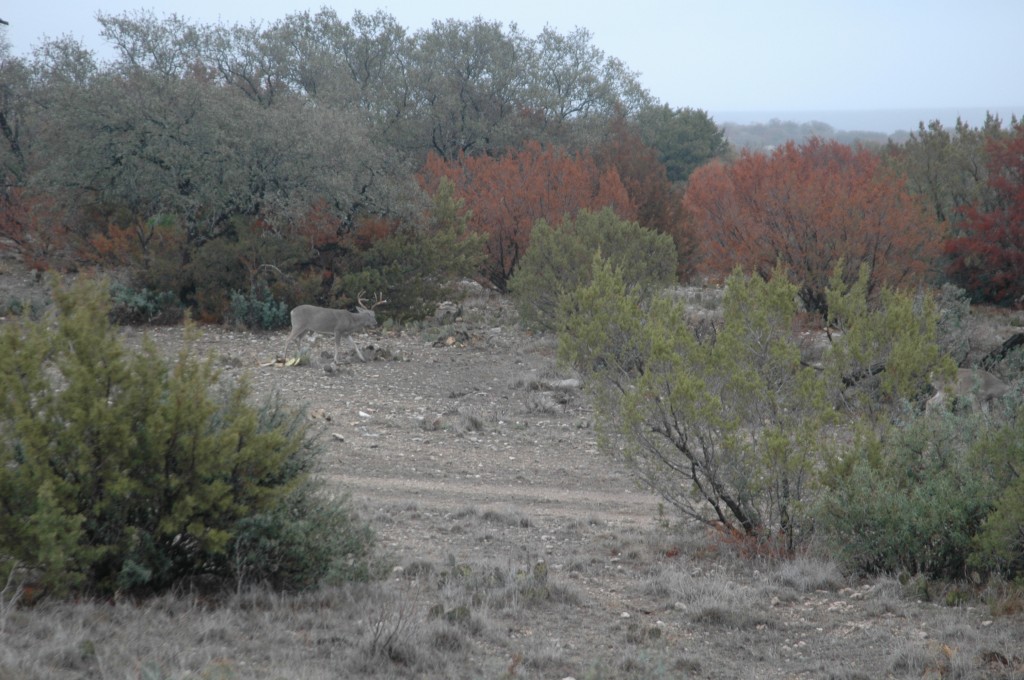
Note: Deer & Deer Hunting Editor Dan Schmidt has just returned from a weeklong rut hunt near Eldorado, Texas. This is the second installment of a five-part blog series on his adventure. Check back each day this week for updates.
There is something about the first day of a hunt. It doesn’t have to be opening day of the season. It could merely be the first day of a three-day getaway. The same feeling comes over me every time: the butterflies in the stomach; the anticipation of what might show up when daylight filter across the landscape; the “newness” of the experience.
I certainly had those feelings the morning of my first sit here at Steve and Michelle Anderson’s Vatoville Outdoors ranch near Sonora, Texas, last week.
The initial hints of daylight revealed several deer lurking in the nearby Texas scrub brush. We were hunting a large chunk of what-used-to-be cattle pasture and is now, well, essentially nothing but dead trees, dirt and surface limestone rocks. The extensive drought this region has experienced over the past two years is something to behold. The summer of 2011 brought extreme heat to this entire state, including 63 days that experienced daytime highs in excess of 100 degrees. The prolonged heat and lack of rain has been a brutal double-whammy on the area’s deer and deer hunting prospects. Steve reports that his ranch has only received two significant rainfalls in two years, and one was yesterday.
“We’ve had no choice but to feed these deer (protein pellets) year-round,” guide Billy Bob “Bunk” Galbreath whispered to me as we were waiting for full daylight. “If we hadn’t, we probably wouldn’t have a single deer on this property. In fact, many of the neighboring landowners, and a lot of the high-fence places (who didn’t feed protein) are experiencing that very thing right now.”
They say Mother Nature can be harsh and cruel. When daylight finally does come, and I put my Kowa binoculars to work, I confirm those charges firsthand. Before the distant spin feeder goes off, I spy what I think are two fawns laboring across the pasture. They’re absolutely puny. I’m estimating that these two deer might, and I do stress might, weigh 100 pounds on the hoof — combined. Then, Billy Bob shocks me with his next statement.
“Those aren’t fawns,” he says. “Those are both adult does.”
We sit for about a half-hour, and then the feeder goes off. It doesn’t take long until we’re covered up in deer: Does, fawns, spike bucks and basket racks literally come out of the woodwork, noses to the ground looking for food. Some of these deer look weak, but others are surprisingly healthy. That can only be a confirmation of Anderson’s wise feeding program.
Before we headed out this morning, Billy Bob explained that I could shoot two bucks on this trip: a management buck (eight points or less), and a trophy buck (any size).
“There are two exceptions,” he said while pulling two trail camera photos out of his pocket. “These two deer (a 25-inch wide 10-pointer, and a huge nontypical) are special to the ranch. We’ve been watching both of them for many years, and we just want to keep them around.”
No problem, I thought. Besides, what are the odds that we’d even see these bucks, given the incredible size of this place — 9,000+ acres. Yep, famous last words.
We sat watching younger bucks nose does around the pasture for several hours. One doe in particular had to be close to estrus, as a decent-sized 8-pointer bird-dogged her relentlessly for more than a half-hour. He simply would not let this doe stop even for a moment to grab a few spilled grains. I was contently watching the show with my binocs when the doe burst out from the brush about 100 yards in front of the stand and sprinted to the west. Hot on her heels was a big-bodied deer.
“That has got to be a buc….HOLY BUCKETS!” I gasped as a rack the size of a laundry basket jumped into clear focus.
I instinctively reach for my rifle.
“Wait a minute,” Billy Bob whispers. “Yeah, that Wavos (his nickname for this buck). Sorry, but we’re only going to be able to watch him.”
I’d be lying if I said I wasn’t immediately disappointed. But you know what? After watching that buck strut his stuff and nudge does for the rest of morning, I can honestly say I came back camp with a sense of satisfaction I’ve never before experienced without pulling the trigger. The best deer hunts are those that are jam-packed with close encounters. I can’t wait to see what the next three days are going to bring.
